Arnold Schwarzenegger’s impact on bodybuilding is monumental, setting standards that still inspire gym-goers today. Known not just for his charismatic presence on screen and future political career, Arnold’s dedication to developing an all-time great physique has made his workouts the stuff of legend. Many consider Arnold to be the GOAT of the Mr. Olympia, the greatest bodybuilding competition in the world.
Among Arnold’s amazing workouts, his back workout routine stands out for its intensity and effectiveness, designed to build a broad, muscular back capable of winning 7 Mr. Olympia titles.
His back wasn’t just massive; it was sculpted with precision through a routine that emphasized both strength and symmetry. The symmetry and aesthetically pleasing look to his back is what made him the best in what is considered “the golden era” of bodybuilding physiques.
His philosophy of combining volume with intensity transformed how bodybuilders trained and his routines became a template for those aiming to achieve similar success.
The Back Muscles Explained, Briefly

The back is made up of a complex group of muscles that work together to support the spine, facilitate movement of the torso, and handle the motions of the arms and shoulders. Here are the key muscle groups:
- Latissimus Dorsi (Lats): These are the largest muscles of the back, spanning the lower mid-back and are responsible for pulling the shoulers down and back.
- Trapezius (Traps): Located from the neck to the middle of the back across the shoulders, the trapezius muscles move the scapulae (shoulder blades) and support arm movements.
- Rhomboids: These muscles, lying underneath the trapezius, play a crucial role in retracting the scapula, which means pulling the shoulder blades together.
- Erector Spinae: This muscle group runs vertically along the entire length of the back, from the sacrum to the base of the skull. It functions to extend and rotate the back, and hold the spine upright (maintain posture).
How Arnold Built His Back Workouts
Arnold emphasizes the need of a meticulously planned back training program to make sure there is comprehensive muscle development.
He points out that just performing various pull-down exercises, which primarily develop lat width, is not a proper back workout. A strong back routine must also include exercises that enhance the thickness of the back, the lower lats, and the definition and strength of the lower back. Basically, you need to hit all parts of the back muscles!
Arnold suggests starting with fundamental exercises like Deadlifts and Chin-Ups, gradually incorporating more complex movements such as Hyperextensions, Good Mornings, different pulldown variations, and rowing exercises.
He talks about the importance of variety, especially in advanced and competition training, to target all critical areas of the back and prevent the development of weak points.
Detailed Breakdown of Arnold’s Back Workout
Arnold’s approach to building a muscular back was methodical and balanced, targeting every muscle group effectively and with intensity. Here’s how he structured his iconic back workouts:
Wide-Grip Pull-Ups
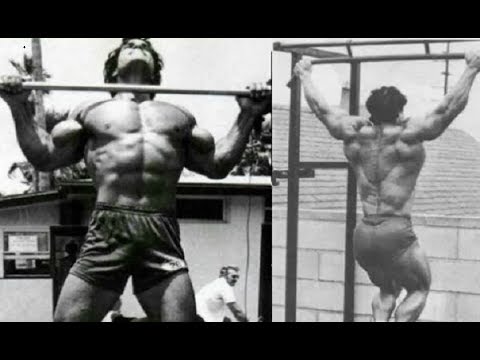
The Wide-Grip Pull-Up is one of Arnold’s all time favorite back exercises. He claims that this exercise, as well as lat pulldowns, are irreplaceable for building huge lats that give you that winged look.
Arnold believed that touching your chest to the bar gives you a slightly longer range of motion, so that you can cheat a few reps at the end even if you are tired. This means you can work the muscle to complete exhaustion.
This exercise also engages the biceps, shoulders, and core, contributing to upper body strength and a wider back, which enhances the V-taper physique. Arnold loved his compound exercises, and this could be right at the top.
How to Do Wide-Grip Pull-Ups:
- Grab the pull-up bar with an overhand grip, hands placed as wide as you can.
- Hang from the bar and pull yourself up, try to touch the top of your chest to the bar.
- At the top, hold for a moment, then lower yourself back to the starting position slowly
Sets/Reps: Perform 5 sets of 8-12 reps, decreasing the reps as you go further into the sets.
T-Bar Rows
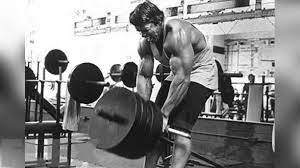
Next up is the t-bar row. This is an exercise many forget about, but Arnold emphasizes how this exercise will give your back the thickness in muscle that you need to pair up with those winged lats.
T-Bar Rows target the middle back muscles, including the rhomboids and the middle and lower trapezius. This exercise is just one variation of the row that is necessary for enhancing overall back thickness and strength. You could substitute these for cable rows, barbell rows, or dumbbell rows, but the t-bar was simply Arnold’s go-to version.
Arnold emphasizes that this is an upper back exercise and that you should not be lifting the bar with your lower back or legs. He says that you should not be swaying or jerking your back up during the movement, otherwise you’re ego-lifting and need to lessen the weight.
Never bend over and hunch your back, or else you could seriously injure yourself.
By using a narrow grip, the t-bar row will work the outer lat and not the inner back so much due to the limited range of motion. However, this means that you can lift more weight than you could with the barbell rows, so it is good for power.
How to Do T-Bar Rows:
- Stand on a block with your feet a bit closer than shoulder-width,
- Slightly bend the knees, bend down and grab the handles of the T-Bar with an overhand grip.
- Straighten your legs slightly and lift up until your body is at about a 45-degree angle.
- Lift the weight up to touch your chest,
- Lower the weight and fully extend the arms, but keep the weight off the ground.
- Repeat
Sets/Reps: 3 sets of 8-10 reps.
Bent-Over Barbell Rows
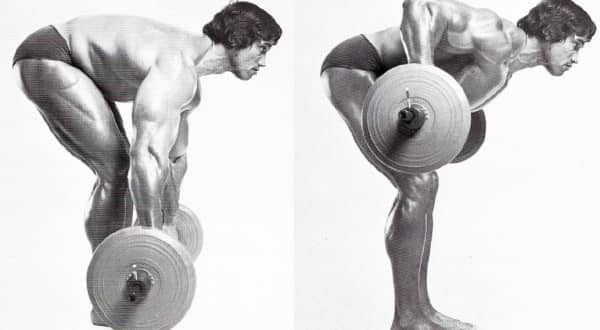
In Arnold’s encyclopedia, Arnold talked about the importance of the bent-over barbell row. Arnold says this is one of the best exercises for getting a full range of motion, and building thickness in the back. He also adds that this exercise will add density to your lower back.
Arnold changed the game with these rows when he would stand on top of a bench, so that he could bring the barbell even lower than he could if he was standing on the floor. Arnold new that a full ROM builds bigger muscles, plain and simple. Make sure to squeeze at the top of each rep, and control the movement as much as you can.
How to Do Bent-Over Rows:
- Stand with feet about 6-12 inches apart, with your knees slightly bent.
- Bend forward at the hips until your back is almost parallel to the floor.
- Note: This is where Arnold differs from many, as today in the gym you see many doing a bend at about 45 degrees, when Arnold is adamant that almost 90 degrees is best for muscle development.
- Keep your back straight and let the bar hang with your arms fully extended below you.
- Using the muscles of the back, lift the bar upward until it touches the upper abs, feeling the squeeze.
- Lower it back down, controlling the eccentric part of the rep.
- Go again!
By the time you are reaching failure, Arnold says it is OK to cheat the last few reps to completely exhaust the muscle. Arnold also emphasizes the importance of keeping your body steady, so that you involve the lower back muscles rather than just the lats.
And if you lift the bar up toward your chest instead of the lower abs, you involve the biceps too much.
Sets/Reps: 3 sets of 8-10 reps.
One-Arm Dumbbell Rows

Arnold loved the one-arm dumbbell rows because they allowed him to work each side of his upper back in isolation. Arnold states that while you can still go heavy with the dumbbells, this exercise is great because it doesn’t allow your stronger side to do most of the lifting.
Arnold states that going heavy during this exercise is less important than getting the complete range of motion, which will help define the center of the back and build more muscle.
This is one of the best back exercises for building that symmetry that Arnold had down so well.
How to Do One-Arm Dumbbell Rows:
- Grab a dumbbell in one hand, bend forward from the waist and make sure your back is parallel to the ground.
- Place your free hand on the bench.
- Hang the weight down with your arm fully extended, feeling the stretch.
- Turn your hand so your palm faces your body.
- Steadily lift the weight up to your side, concentrating on doing the work with the back rather than the arm.
- Lower the weight slowly and controlled.
- Repeat with the other arm once you exhaust the first side
Sets/Reps: 3 sets of 10-12 reps.
Deadlifts
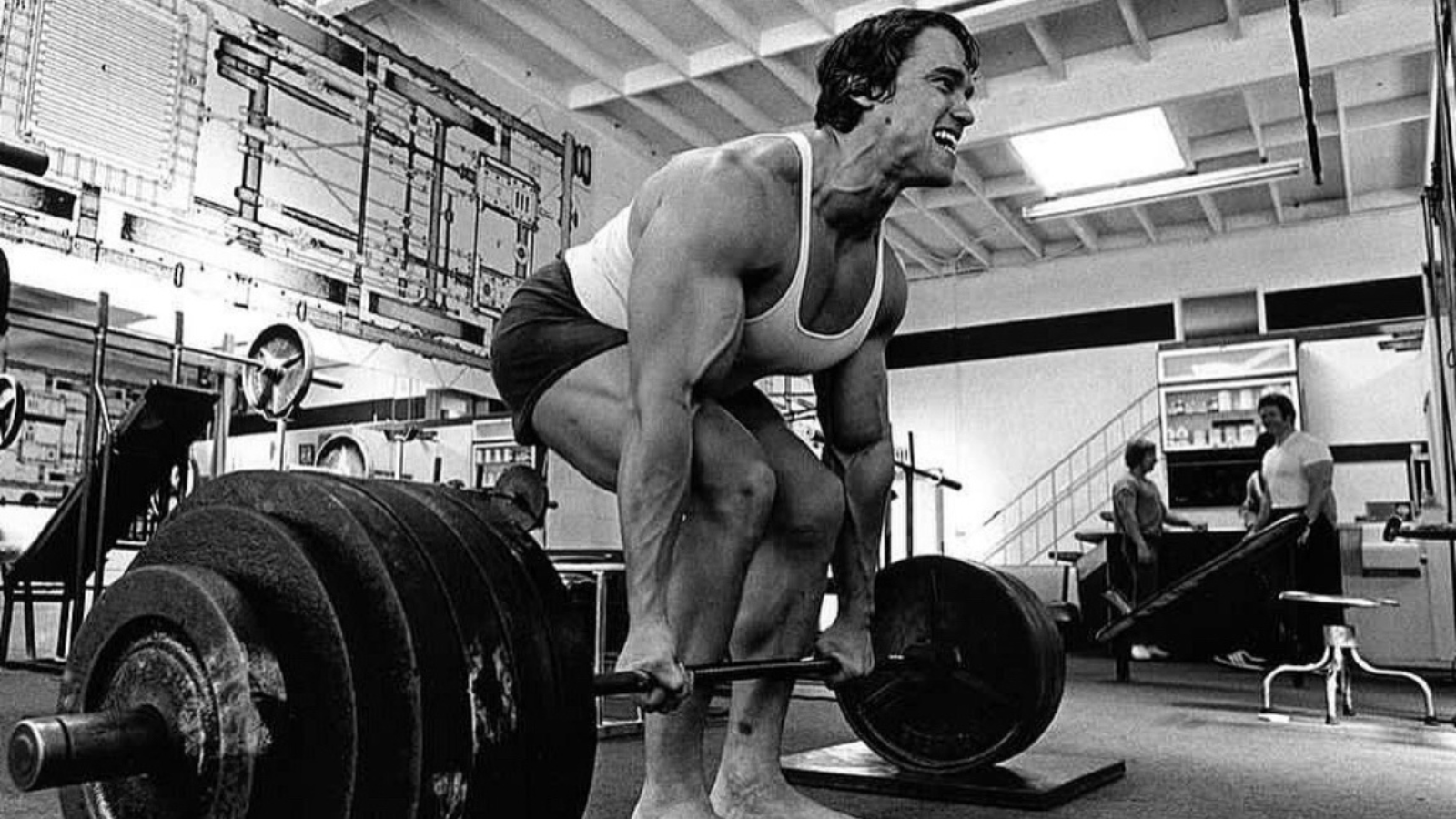
Arnold loved deadlifts because they are a power exercise that involve more muscles than any other exercise during your workout. Deadlifts primarily target the lower back, while also hitting the upper back, trapezius muscles, the glutes, and the legs.
A strong lower back is very important when doing movements like Bent Over Barbell Rows and T-Bar Rows, which put a lot of strain on the lower back.
Arnold emphasizes the importance of keeping your head up and the back very straight during deadlifts in order to distribute the stress on the lower back and reduce the chance of injuries.
How to Do Deadlifts:
- Bend your knees, lean forward, and grab the bar in a medium-wide grip, one hand in an overhand grip, the other in an underhand grip.
- Keep your back straight so you don’t get injured.
- Drive with the legs at the start of the lift.
- Lift until you are standing upright,
- Throw the chest out and shoulders back as if coming to attention like a solider.
- Lower the weight by bending your knees, leaning forward, and touching the weight to the floor
- Begin your next rep.
Sets/Reps: 4 sets of 6-8 reps.
Arnold’s Tips for Maximizing Back Development
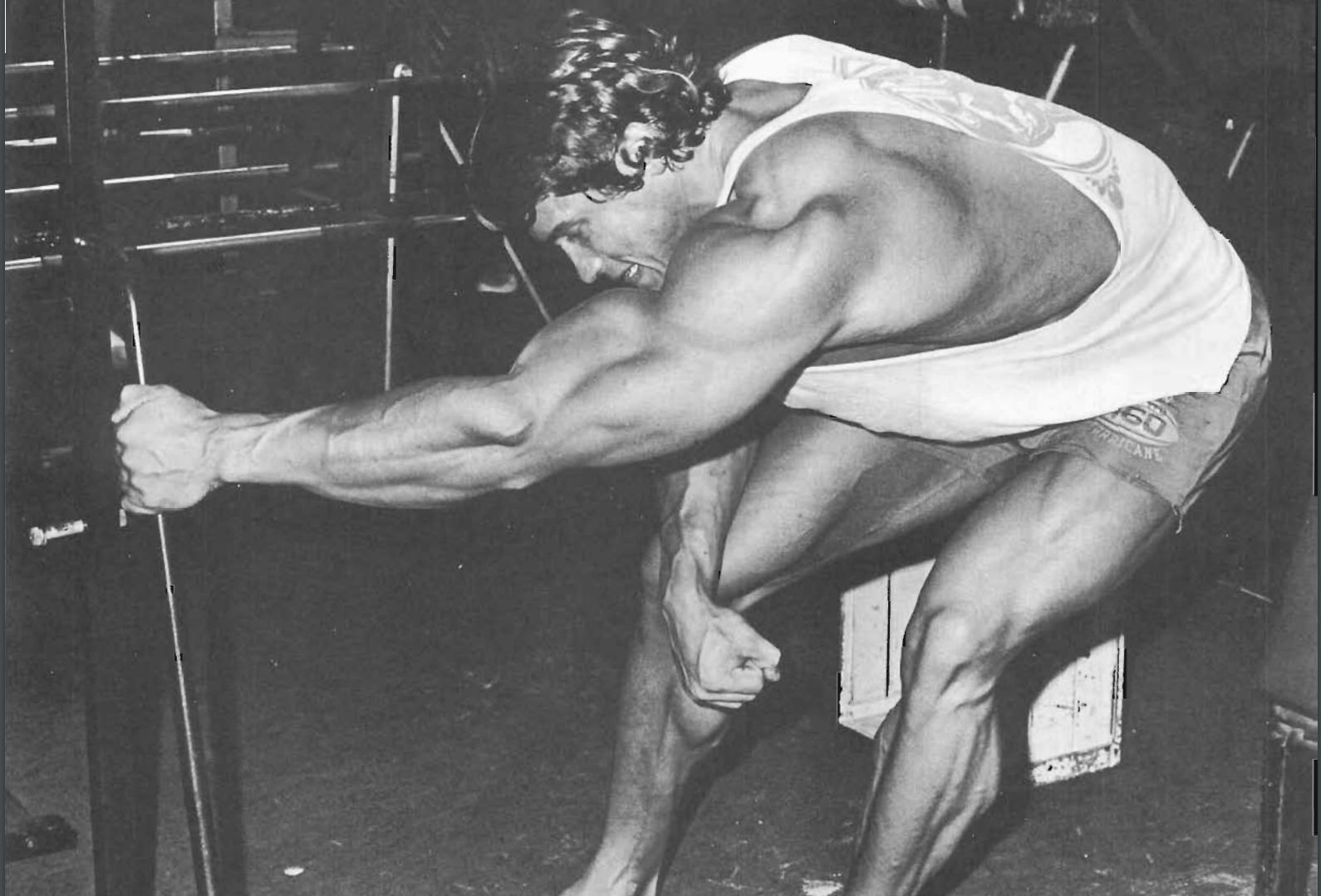
Stretching and Flexing the Back Muscles During Exercises
Arnold emphasizes the importance of flexing and posing the back muscles between sets to gain better muscle control, which is crucial for displaying them effectively in bodybuilding competitions. He advocates for continually stretching the lats to enhance their length and lower tie-ins at the waist.
Arnold suggests flexing the back or striking poses like the back double-biceps during rest periods in workouts involving rows and pullovers, to maintain muscle pump and warmth. Also, during lat workouts such as chin ups and pulldowns, he recommends grabbing something sturdy to stretch the lats thoroughly between sets.
This not only increases the muscle’s range of motion and depth of contraction but also helps in developing the lower sections of the lats that extend down to the waist.
Weak Point Training
Arnold stresses the importance of targeted back training, saying that many bodybuilders have underdeveloped backs due to poor visualization and technique. He criticizes common errors like overusing weight, which leads to relying on the lower back or shoulders instead of isolating the back muscles effectively.
He talks about the need for understanding the primary function of the back muscles—to pull the shoulder girdle down and back—and advises bodybuilders to concentrate on using the arms just as links, not primary movers, during back exercises.
He also talks about the importance of adjusting workouts to focus on weaker sections of the back as one progresses, helping make sure there is balanced and comprehensive back development.
Mind-Muscle Connection
Arnold often emphasized the importance of the mind-muscle connection. He believed that by focusing intensely on the muscles being worked, one could increase the effectiveness of each exercise.
To enhance this connection, Arnold recommended visualizing the muscles expanding and contracting with each rep, making sure that every movement was deliberate and maximizing muscle engagement.
Varying Grip and Angles

To target the back muscles from multiple angles, Arnold varied his grip and the angle of execution in his exercises. For instance, he would alternate between wide, medium, and close-grip pull-ups to engage different parts of the lats and upper back.
Adjusting grips and angles helps stimulate muscle growth across the entire back by hitting both the larger muscles and the smaller, supportive muscle groups.
Incorporating Drop Sets
Arnold was a proponent of using drop sets to push beyond muscular failure. This technique involves performing an exercise until failure and then immediately reducing the weight and continuing to do more reps until failure is reached again.
This method was particularly effective for Arnold in exhausting the muscles thoroughly, to make sure that every fiber was activated and engaged for maximum growth.
Controlled Lifting with Explosive Movement
While Arnold stressed the importance of lifting with control to avoid injury, he also advocated for incorporating explosive movements in his lifts. For example, in rowing movements, he would pull the weight towards him quickly and release it slowly.
This explosive action stimulates the fast-twitch muscle fibers, which are crucial for muscle growth and strength.
Conclusion
Emulating Arnold Schwarzenegger’s back workout routine offers more than just physical growth; it’s a lesson in discipline, focus, and the pursuit of excellence. While not everyone can be a Mr. Olympia, incorporating parts of Arnold’s philosophy and workouts can significantly enhance your own training results.
Remember, consistency is key—pair your workouts with proper nutrition, adequate rest, and a relentless commitment to improvement. Whether you’re a beginner or a seasoned gym-goer, Arnold’s methods can help sculpt a powerful back and a stronger physique.
To learn more about how to train like Arnold, read our articles on Arnold’s arm workout, chest workout, leg workout, and shoulder workout.
Sources
- Schwarzenegger, Arnold, and Bill Dobbins. The New Encyclopedia of Modern Bodybuilding. Simon & Schuster, 1998.







